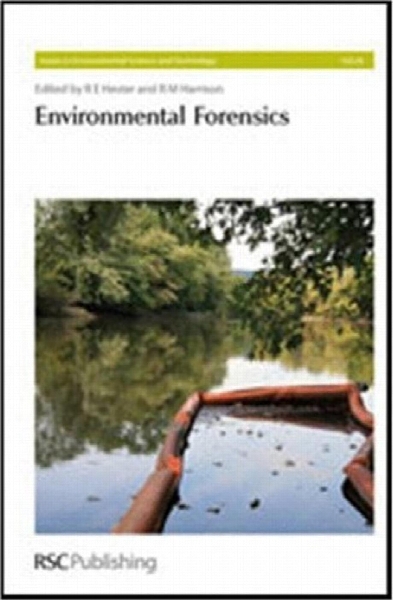Environmental forensics
- نوع فایل : کتاب
- زبان : انگلیسی
- مؤلف : R E Hester; Roy M Harrison; Royal Society of Chemistry (Great Britain)
- ناشر : Cambridge, UK : RSC Pub.
- چاپ و سال / کشور: 2008
- شابک / ISBN : 9780854049578
Description
1 Introduction 1 2 The Legislative Framework for Environmental Forensics 1 2.1 National Legislation 1 2.2 Regional Legislation 4 2.3 US Legislation 5 3 Source Identification 6 3.1 Illegal Discharges 8 3.2 Fugitive Emissions or Discharge 9 3.3 Deliberate ‘Fly-tipping’ 9 3.4 Historical Discharges 9 3.5 Altered Environmental Processes 9 4 Tools for Source Apportionment 10 4.1 Chemical Approaches 10 4.2 Biological Approaches 12 5 Summary 14 References 14 Microbial Techniques for Environmental Forensics Andrew S. Ball, Jules N. Pretty and Rakhi Mahmud 1 Introduction 17 2 Traditional Microbial Forensics 17 2.1 Community-level Physiological Profiling 18 2.2 Phospholipid Fatty Acid Profiling 19 3 Emerging Microbial Analyses 19 3.1 Microbial Analysis and Environmental Forensics 19 3.2 The Basis of Molecular Microbial Forensic Techniques 20 3.3 Ribosomes 21 Issues in Environmental Science and Technology, No. 26 Environmental Forensics Edited by RE Hester and RM Harrison r Royal Society of Chemistry 2008 vii 3.4 Ribosomal RNA and Taxonomy 22 3.5 Polymerase Chain Reaction (PCR) 22 4 PCR-based DNA Fingerprinting Techniques 25 4.1 Denaturing Gradient Gel Electrophoresis and Its Derivatives 25 4.2 Single-stranded Conformation Polymorphism Analysis (SSCP) 28 4.3 Terminal Restriction Fragment Length Polymorphism (TRFLP) 29 5 Limitations of PCR-based Methodologies 31 6 Forensic Interpretation of Profiles 31 7 Conclusions 33 References 33 Spatial Considerations of Stable Isotope Analyses in Environmental Forensics James R. Ehleringer, Thure E. Cerling, Jason B. West, David W. Podlesak, Lesley A. Chesson and Gabriel J. Bowen 1 A Background in Stable Isotopes 38 1.1 Stable Isotopes – a Primer 38 1.2 Isotope Ratio Composition is Presented in Delta Notation 38 1.3 Gas Isotope Ratio Mass Spectrometer 39 2 The Stable Isotopes of Water 40 2.1 The Meteoric Water Line 40 2.2 Isotopes of Water on a Spatial Scale 40 3 Spatial Forensic Applications Based on H and O Isotopes 42 3.1 Cotton as an Example of Plant Sourcing 42 3.2 Wine as an Example of Food Sourcing 44 3.3 Keratin as an Example of Animal Sourcing 44 4 Opportunities to Examine C and N Isotopes on a Spatial Basis 47 4.1 The Imprint of Photosynthetic Pathways 47 4.2 Cocaine Origins are Reflected in C and N Isotopes 49 References 50 Diagnostic Compounds for Fingerprinting Petroleum in the Environment Scott A. Stout and Zhendi Wang 1 Introduction 54 1.1 Petroleum Genesis, Refining, Weathering and Mixing 55 1.2 The Philosophy of Chemical Fingerprinting 57 2 Diagnostic Compounds 60 2.1 Trimethylpentanes 60 2.2 Gasoline Additives 61 viii Contents 2.3 Diamondoids 65 2.4 Acyclic Alkanes 65 2.5 Sesquiterpanes 69 2.6 n-Alkylcyclohexanes 70 2.7 Diterpenoids 73 2.8 Polycyclic Aromatic Hydrocarbons 73 2.9 Triterpenoids 79 2.10 Steroids 91 3 Conclusions 96 References 97 Perchlorate – Is Nature the Main Manufacturer? Ioana G. Petrisor and James T. Wells 1 Introduction 105 1.1 Changing Perspectives 105 1.2 The Perchlorate Legacy – Emergence of a Long-used Contaminant 106 1.3 Keys to Forensic Investigations 107 2 Environmental Forensic Investigation of Perchlorate 108 2.1 Perchlorate – Unique Chemical 108 2.2 Sources of Perchlorate 110 2.3 Tracking Perchlorate in the Environment 119 3 Conclusions 127 References 127 Tracking Chlorinated Solvents in the Environment Ioana G. Petrisor and James T. Wells 1 Introduction – The Environmental Legacy 130 2 The State of Knowledge 132 3 Sources and Uses 132 4 Traits and Environmental Behavior 133 5 Significance of Environmental Forensics for Site Remediation 137 6 Forensic Techniques for Tracking the Source and Age of Chlorinated Solvents 137 6.1 Chemical Fingerprinting 138 6.2 Isotopic Fingerprinting 148 6.3 Dendroecology 150 7 Conclusions and Perspectives 151 References 151 Contents ix Groundwater Pollution: The Emerging Role of Environmental Forensics Stanley Feenstra and Michael O. Rivett 1 Introduction 153 2 The Fundamental Questions 154 3 Subsurface Forensic Methods 156 3.1 Site History 156 3.2 Site Testing 157 3.3 Historical Knowledge of Subsurface Contamination 162 4 Examples of Some Important and Challenging Specific Questions 162 4.1 What Was the Chemical Material That Was Released? 162 4.2 Does the Groundwater Plume Track Back to the Releases or Source Zones? 166 4.3 Can the Contaminants be Traced Back to the Source Zone? 167 5 Concluding Discussion 170 References 171 Subject Index 173
"This volume contains authoritative articles by a number of the leading practitioners across the globe in the environmental forensics field and aims to cover some of the main techniques and areas to which environmental forensics are being applied. The content is comprehensive and describes a number of the key areas within environmental forensics."--BOOK JACKET.


